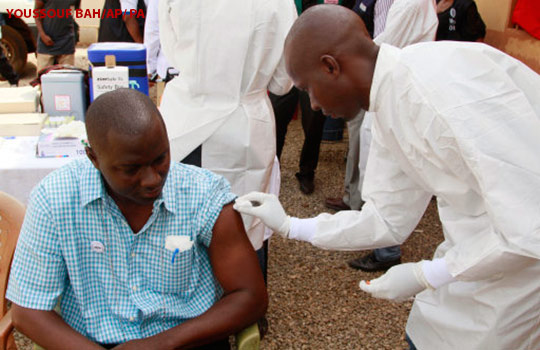A combination of strategies are required to save lives

A US$1-billion initiative was launched earlier this year with the aim of having vaccines ready in order to prevent the next global pandemic. The Coalition for Epidemic Preparedness Innovations (CEPI) was launched at the World Economic Forum in Davos, Switzerland, with US$460 million in backing from Norway, Germany, Japan, the Wellcome Trust and the Bill & Melinda Gates Foundation.1-3 The organization expects to raise the full US$1 billion that it needs for the next 5 years by the end of this year.1-3 Moreover, CEPI has selected 3 pathogens on which to focus their initial vaccination efforts.1-3 However, the vaccines for these pathogens are in the very early stages of development (preclinical stage) and may take decades before they are ready for use in an epidemic.2 Despite Bill Gates’ claim that DNA/RNA vaccines (third-generation vaccines) can serve as a “vaccine pipeline” to accelerate vaccine development against other pathogens, there is no licensed DNA or RNA vaccine approved by the US Food and Drug Administration for human use.4 There is no Th1-adjuvant in existence which may prove to be a vital component of a future viral vaccine. Furthermore, a vaccine, once developed, cannot be tested in a Phase II or III clinical trial as there are few or no cases outside an epidemic for most of the potential pathogens. I believe CEPI’s focus solely on vaccination is a mistake. CEPI needs to carefully consider other innovations (passive immune therapy, antiviral drug discovery, adjuvant discovery, high-throughput viral genome sequencing) and capacity building initiatives (diagnostics, real-time reporting, zoonotic surveillance in animal reservoirs, mathematical modelling, GIS risk mapping) that will compliment vaccination.
Potential pathogens
Emerging infectious diseases are primarily zoonotic and viral (HIV, SARS, Ebola, MERS-CoV, Lassa Fever, Nipah virus), originating in wildlife populations from the tropics.5 WHO recently deemed 11 pathogens as the most likely to cause severe outbreaks but the rationale for this list is unclear. CEPI has chosen only 3 pathogens (Nipah virus, Lassa fever and MERS-CoV) to commence vaccination efforts but again what is the rationale for their selection? Nipah virus is a zoonotic disease with high fatality rates. Human-to-human transmission is common in Bangladesh and novel paramyxoviruses continue to emerge.6 Lassa fever is a viral haemorrhagic illness responsible for disease outbreaks in West Africa.7 It is a zoonosis with its reservoir host (the mouse Mastomys natalenis) distributed across sub-Sahara Africa.7 MERS-CoV is another zoonotic disease with pandemic potential. Like Lassa fever and Nipah virus, there is no specific drug treatment and vaccine development is still at the stage of animal experimentation.8 In recent years multiple zoonotic influenza A strains have emerged in humans (H5N1, H5N6, H7N9, H10N8) that have pandemic potential, but the current quadrivalent influenza vaccine (A-H1N1, A-H3N2, B- Phuket/3073/2013, B- Brisbane/60/2008) does not cover their serotypes.9 The U.S. Centres for Disease Control and Prevention (CDC) ranks H7N9 as the flu strain with the greatest potential to cause a global pandemic. Given the severe illness and fatalities associated with these influenza A strains clearly they should be a CEPI priority.
Building capacity
Vaccines for candidate pathogens may be decades away and new pathogens may arise from the tropics for which there is no vaccine. The recently developed Ebola vaccine (rVSV-ZEBOV) was built on the back of 40 years of research and the durability of the vaccine is questionable.10 No licensed vaccine is 100% efficacious or effective. We therefore, must have other strategies in place if a vaccine is not available. This would include building national capacities of low and middle-income countries. According to a recent report by the United Nations International Labour Organization almost half of the world’s population does not have access to healthcare.11 In Africa the number of rural people who don’t have access to healthcare is 83%.11 Most of the existing rural healthcare centres in Sub-Saharan Africa currently lack access to clean water, electricity, medical equipment, essential medicines, IT, and trained staff. During a pandemic it is these rural healthcare centres that will serve as the first line of defense.
At the World Economic Forum this year (2017) President Alpha Condé of Guinea made a passionate plea for help for improvements in national healthcare systems, community health services, and technology transfer in Africa. But to date this has largely been ignored. The World Bank’s new Pandemic Emergency Financing Facility does not cover pandemic preparedness or national reconstruction efforts. CEPI has put all its eggs in the vaccine basket, but vaccines may not pan out and vaccine-based solutions also ignore the underlying problem of building national capacities and surveillance in the developing world. Real solutions will come from a broader focus as advocated by Alma-Ata declaration of 1978.12, 13
Allen Ross is a professor and chair of Tropical Medicine & Infectious Diseases with Griffith University, Australia, and a Physician Scientist with Menzies Health Institute Queensland. His expertise and research interests lie in the realm of global health, medical microbiology, tropical infectious diseases, disease control, pandemic planning, and vaccination.
I thank the National Health and Medical Research Council, Australia, for providing financial support for my research.
Competing interests: I have read and understood the BMJ policy on declaration of interests and have no relevant interests to declare.
Provenance and peer review: Not commissioned; externally peer reviewed.
References:
- Brende B, Farrar J, Gashumba D, Moedas C, Mundel T, Shiozaki Y, Vardhan H, Wanka J, Røttingen JA. CEPI-a new global R&D organisation for epidemic preparedness and response. Lancet. 2017 Jan 21;389(10066):233-235. doi: 10.1016/S0140-6736(17)30131-9.
- Butler D. Billion-dollar project aims to prep vaccines before epidemics hit. Nature. 2017 Jan 18;541(7638):444-445. doi: 10.1038/nature.2017.21329.
- Røttingen JA, Gouglas D, Feinberg M, Plotkin S, Raghavan KV, Witty A, Draghia-Akli R, Stoffels P, Piot P. New Vaccines against Epidemic Infectious Diseases. N Engl J Med. 2017 Jan 18. doi: 10.1056/NEJMp1613577.
- Marć MA, Domínguez-Álvarez E, Gamazo C. Nucleic acid vaccination strategies against infectious diseases. Expert Opin Drug Deliv. 2015;12(12):1851-65. doi: 10.1517/17425247.2015.1077559. Review.
- Jones KE, Patel NG, Levy MA, Storeygard A, Balk D, Gittleman JL, Daszak P. Global trends in emerging infectious diseases. Nature 2008;451(7181):990. http://dx.doi.org/10.1038/nature06536.
- Clayton BA. Nipah virus: transmission of a zoonotic paramyxovirus. Curr Opin Virol. 2017 Jan 11;22:97-104. doi: 10.1016/j.coviro.2016.12.003.
- Mylne AQ, Pigott DM, Longbottom J, Shearer F, Duda KA, Messina JP, Weiss DJ, Moyes CL, Golding N, Hay SI. Mapping the zoonotic niche of Lassa fever in Africa. Trans R Soc Trop Med Hyg. 2015 Aug;109(8):483-92. doi: 10.1093/trstmh/trv047. Review.
- Choi J, Kim MG, Oh YK, Kim YB. Progress of Middle East respiratory syndrome coronavirus vaccines: a patent review. Expert Opin Ther Pat. 2017 Jan 25:1-11. doi: 10.1080/13543776.2017.1281248.
- Bui CM, Chughtai AA, Adam DC, MacIntyre CR. An overview of the epidemiology and emergence of influenza A infection in humans over time. Arch Public Health. 2017 Mar 27;75:15. doi: 10.1186/s13690-017-0182-z.
- Geisbert TW. First Ebola virus vaccine to protect human beings? Lancet. 2016 Dec 22. pii: S0140-6736(16)32618-6. doi: 10.1016/S0140-6736(16)32618-6.
- http://www.un.org/apps/news/story.asp?NewsID=50699#.WQ_3gId-8_x
- Lawn JE, Rohde J, Rifkin S, Were M, Paul VK, Chopra M. Alma-Ata 30 years on: revolutionary, relevant, and time to revitalise. 2008 Sep 13;372(9642):917-27. doi: 10.1016/S0140-6736(08)61402-6.
- Perry HB, Dhillon RS, Liu A, Chitnis K, Panjabi R, Palazuelos D, Koffi AK, Kandeh JN, Camara M, Camara R, Nyenswah T. Community health worker programmes after the 2013-2016 Ebola outbreak. Bull World Health Organ. 2016 Jul 1;94(7):551-3. doi: 10.2471/BLT.15.164020. Epub 2016 Jun 2.
